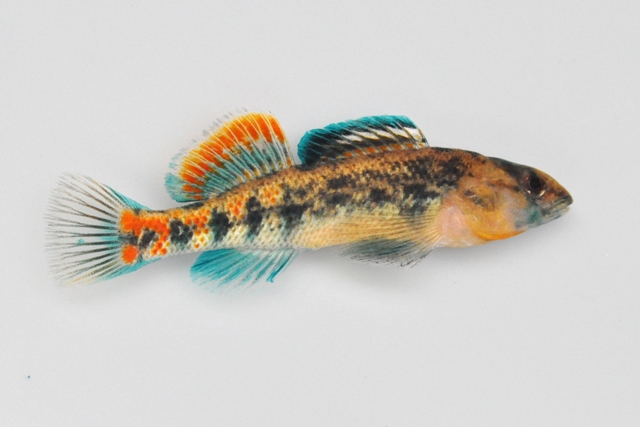Reproduction
Spawn Seasons
The
spawning season for the orangethroat darter is relatively variable
among populations located at different latitudes. In lower latitude
populations (Texas), the spawning season can last more than 7
months, from the end of October to July.
In higher latitude populations (Missouri), the spawning
season is dramatically shortened lasting only a few months from
March to May. Northern
latitude populations near Michigan have two month long spawning
seasons lasting from April to the beginning of June. This is the
nearly the highest latitude that this species can effectively
reproduce any offspring (Hubbs 1985).
|
Figure 2. Female orangethroat
darter. |
Mate Selection
According to a study conducted by Mark Pyron (1995),
the female orangethroat darter (E. spectabile)
doesn’t seem to be influenced by male size, color, or male-male
dominance behavior. Although females don’t prefer a larger sized or
more colorful male, sexual dimorphism does exist within this species
in regards to color (Figures 1 and 2). During spawning, male-male competition was
relatively low: larger sized males did show aggression toward
competing males but the large and small size spawning frequencies
were relatively the same (Pyron 1995).
Pyron observed that the spawning patterns of E. specatibile
were based more on opportunity than specific mate selection;
majority of the spawns that were initiated occurred when only one
male happened to be near the female. Although one male may have
initiated the spawning with another female, sperm competition was high within this
species: multiple males competing for one female.
The spawning process is quite simple as well. When the female is ready to spawn, she buries herself into the substrate of
the spawning site and then the male locates himself above her and
they both release their gametes (1995). Fertilization occurs within
the substrate.
Parental Behavior
Once the spawning activity has occurred, male and female
individuals don't care for their young; orangethroat darters don’t
defend or nurture their young through development as some other aquatic
fish species are known to do. They have no parental care of their
young at anytime during development. Many fish species do defend and
nurture their young in the early stages of development to some
extent, but the E. spectabile is a perfect example of a
fish species that offers no care to their young (Pyron 1995).
___________________________________________________________________


